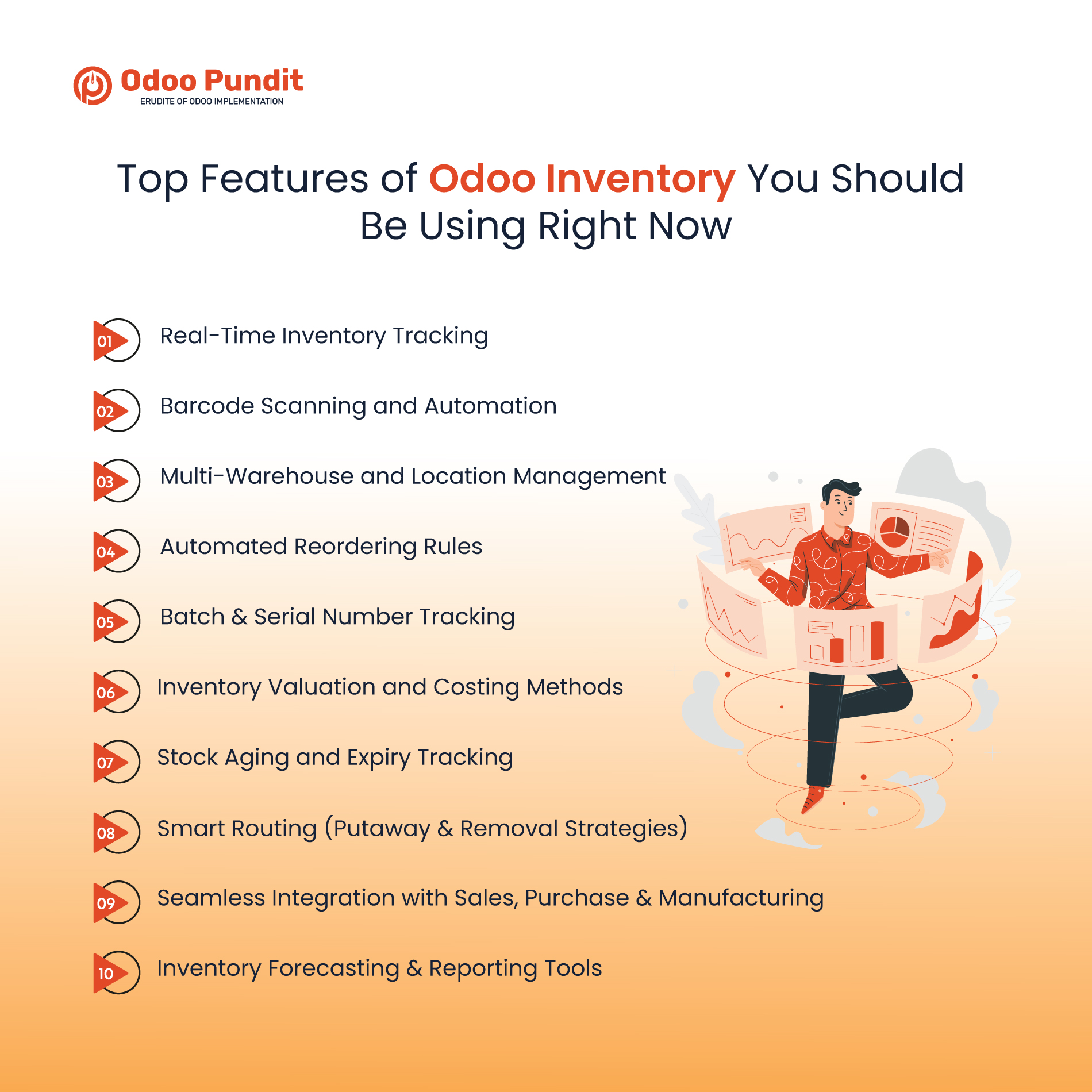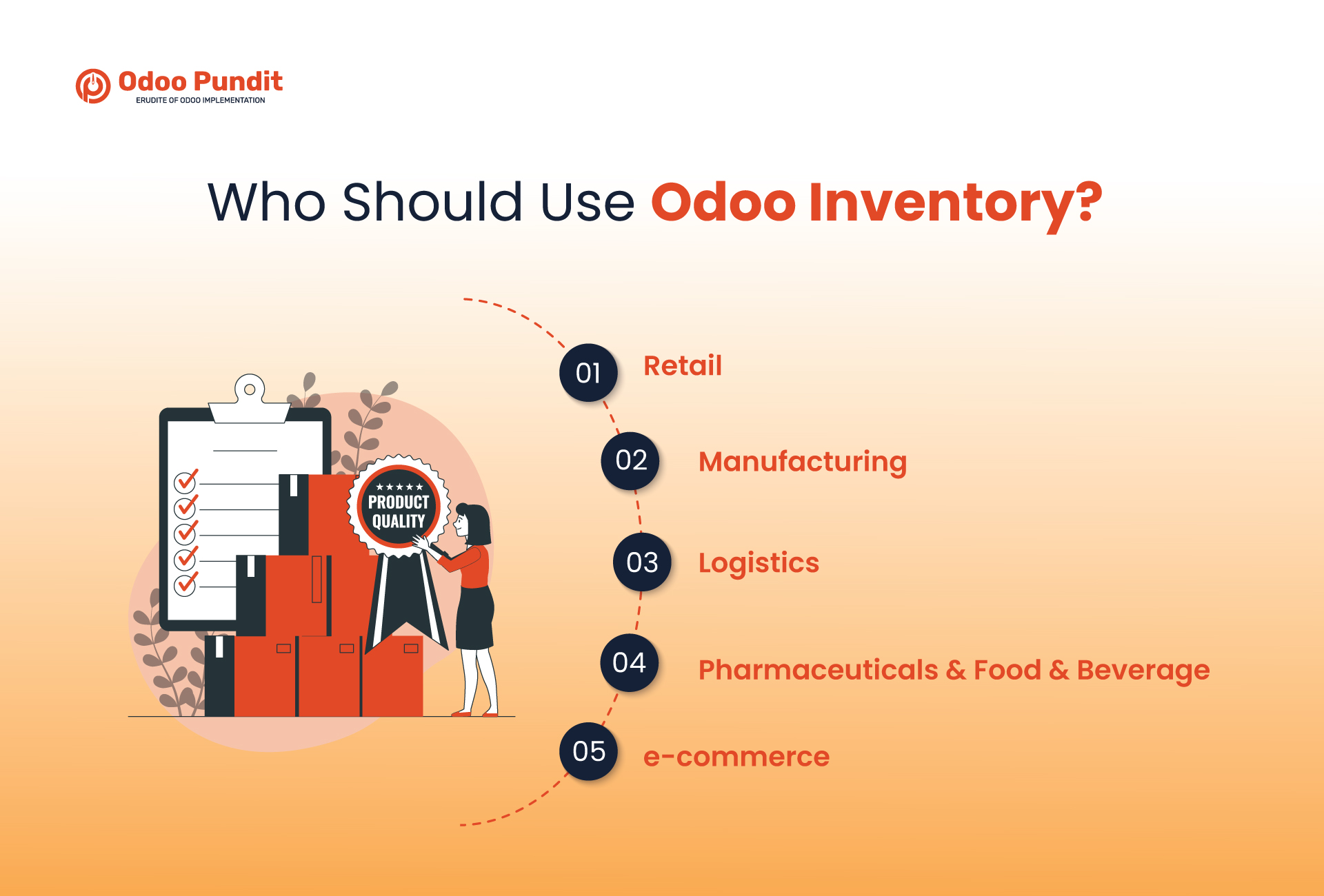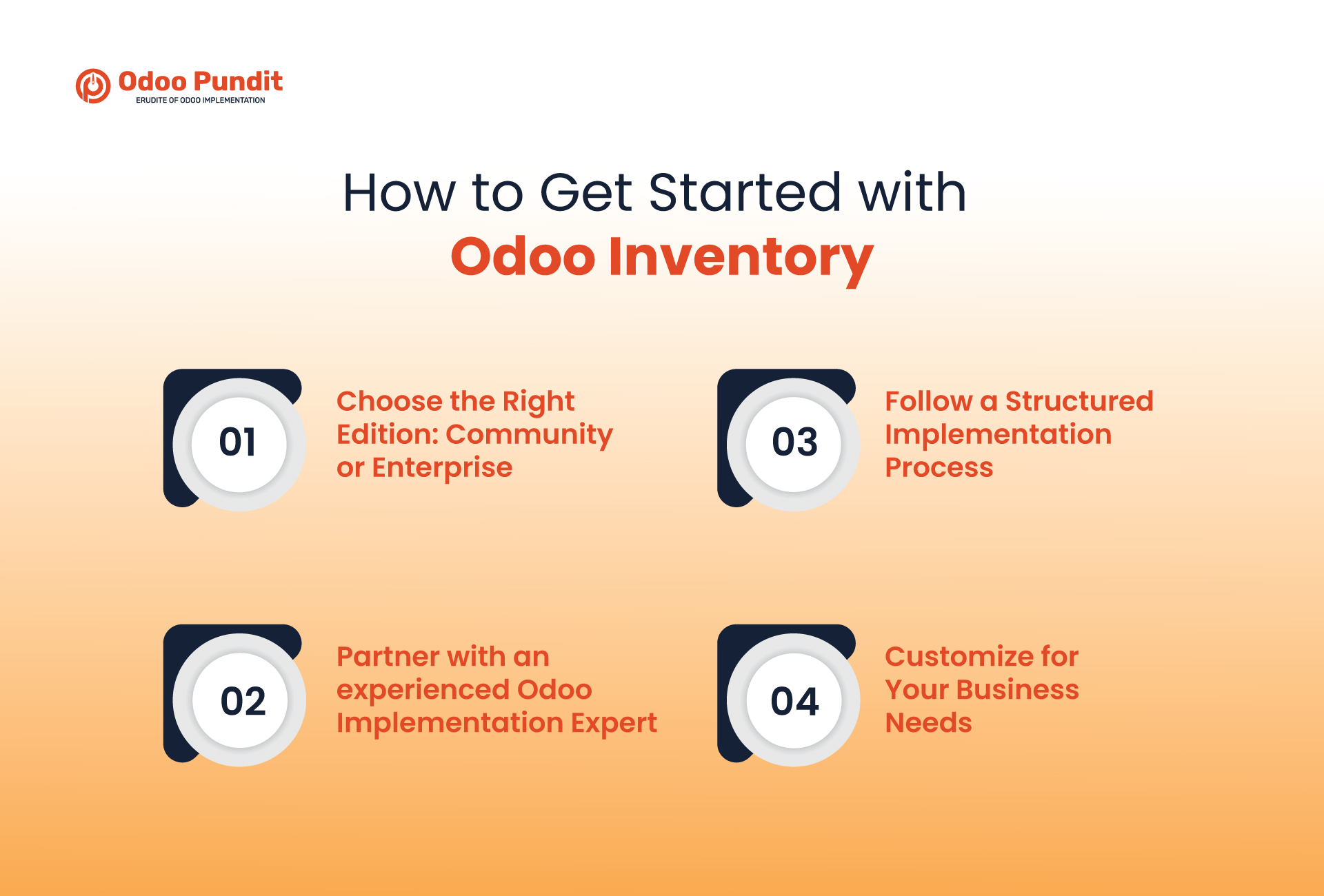Introduction:
No matter if you run a warehouse, a store, or a factory, your inventory system can make or break your business.
Too much stock? You tie up capital and risk dead inventory.
Too little? You miss orders and disappoint customers.
Messy processes? Expect delivery delays, counting errors, and frustrated teams.
This is exactly where modern tools like Odoo Inventory step in.
Odoo Inventory is made for growing businesses that need control, speed, and accuracy. It’s not just about tracking stock. It helps you automate operations, reduce waste, and create a real-time, connected supply chain.
If you use Odoo or are thinking about it, this blog will show you the top features of Odoo Inventory. Start using these today to improve your inventory management.
Let’s dive in.
What Is Odoo Inventory?
Odoo Inventory is a helpful tool for businesses to track their stock. This includes raw materials, finished products, and items in warehouses. It is part of a larger software called Odoo ERP. Companies use Odoo ERP to manage daily tasks like sales, purchases, and accounting. Think of it like a digital assistant that tells you exactly what you have in stock and where it’s stored.
Odoo Inventory is useful because it does more than just list items. It helps manage every part of the inventory process. For example, if a company has multiple warehouses, Odoo can show what’s stored where. It also keeps track of all stock movements, like when goods are received, shipped out, or transferred between locations. This helps avoid confusion and prevents mistakes.
Another great feature of Odoo inventory is its ability to track products using serial numbers, batch numbers, or expiry dates. That means if a customer complains or a product recall happens, the company can quickly trace where a specific item came from. It also sends alerts when stock levels are low, so businesses can reorder items before they run out.
Odoo Inventory also works smoothly with other parts of the Odoo system. When a sale is made, inventory levels update automatically. If a company buys new stock, it’s added to the system in real time. It even connects to the company’s accounts to keep financial records accurate. Overall, the features of Odoo Inventory make stock management easier, faster, and more reliable for any business.
Top Features of Odoo Inventory You Should Be Using Right Now

1. Real-Time Inventory Tracking
Keeping track of inventory by hand or using spreadsheets can lead to costly mistakes. You might run out of stock when you need it most, or accidentally order too much. That’s where Odoo’s real-time inventory management comes in.
With Odoo inventory features, you can see inventory levels in all your warehouses right away. You can see what is coming in, what is going out, and what is moving between locations.
- Inbound shipments show what is arriving.
- Outbound deliveries show what is leaving.
- Internal transfers show what is moving within locations. No more guessing or calling warehouse teams for updates—everything is visible in your system instantly.
This real-time view helps you spot problems before they get worse. For example, if one warehouse is low on a product, you can quickly transfer it from another location. It also means your sales team knows exactly what’s available when talking to customers. This reduces the chances of selling items that are out of stock.
2. Barcode Scanning and Automation
Managing inventory by hand can be slow and full of mistakes, especially with many products. Odoo inventory management fixes this with barcode scanning and automation to speed up your warehouse work and make it more accurate.
With barcode scanners, your team can quickly pick, pack, and ship products without typing details by hand. Odoo supports popular barcode types like GS1 and QR codes. You can also create your own custom barcodes to meet your needs.
Additionally, barcode scanning automates inventory tasks. When items are received, delivered, or returned, the system updates your stock levels automatically. This saves time, cuts down on errors, and keeps your inventory data correct without extra work.
3. Multi-Warehouse and Location Management
If your business has more than one warehouse or different storage areas, tracking inventory can be hard. That’s where Odoo’s multi-warehouse and location management helps.
With Odoo inventory features, you can manage many warehouses from a single dashboard. This means you don’t have to switch between tools or spreadsheets. You can see where every product is stored and how stock moves between warehouses. You can also check what’s available at each location in real time.
Odoo inventory management lets you set up rules for how stock is replenished. You can define zones within warehouses, like receiving, packing, or returns. It can also automate stock transfers when needed. Everything is organized and traceable—no more manual tracking or guesswork.
4. Automated Reordering Rules
Running out of stock at the wrong time can disrupt your operations. That’s why automated reordering is a key feature of Odoo Inventory management. This is especially helpful if you manage many products.
With Odoo, you can set minimum and maximum stock levels for each item. When your inventory is low, Odoo will automatically create a purchase order or a manufacturing order. This depends on your settings.
This means you no longer have to manually check inventory or remember when to reorder. The system takes care of it for you, ensuring you always have just the right amount of stock on hand.
5. Batch & Serial Number Tracking
If you work in an industry where tracking is important, you understand its significance. This is especially true in fields like pharmaceuticals, electronics, and food and beverage. It's crucial to track items accurately. With Odoo’s lot and serial number tracking, you can follow every product during its lifecycle.
Odoo inventory management allows you to assign batch (lot) numbers or unique serial numbers to each product. This helps you trace the movement of a specific item or group, from the vendor, through your warehouse, and to the customer.
Whether you face recalls, warranty claims, or need to meet compliance standards, this feature keeps you audit-ready. You will have a clear trail for every unit.
6. Inventory Valuation and Costing Methods
Knowing your true product cost is important for pricing, profit, and financial reports. Odoo helps with this by supporting multiple inventory valuation methods. These methods include FIFO (First-In, First-Out), LIFO (Last-In, First-Out), and Average Costing.
These methods help you match your costing approach to your business model. For example, if you deal with perishable goods, FIFO ensures older inventory gets sold first. If your prices fluctuate frequently, average costing helps balance the cost over time.
Even better? Odoo’s inventory valuation is automatically linked with the Odoo Accounting module. That means real-time updates on Cost of Goods Sold (COGS), margin analysis, and more, without any manual entry.
7. Stock Aging and Expiry Tracking
If your business sells perishable goods or products that expire, tracking expiration dates is very important. Odoo Inventory features make this easy with stock aging reports and expiry tracking tools.
You can set expiration dates for each product batch or lot. Odoo will automatically keep track of them as they move through your warehouses. The system sends you alerts when items are close to expiring, so your team can act in time.
These features of Odoo inventory management are especially important for pharmaceuticals, food and beverage, cosmetics, and chemicals. Expired inventory can lead to lost revenue or even legal problems.
8. Smart Routing (Putaway & Removal Strategies)
Warehouse efficiency is not just about what you have in stock. It’s also about where items are placed and how they are picked. This is where Odoo’s Smart Routing helps.
With the features of Odoo inventory management, you can set custom rules for putting away new stock and removing old stock. You can use strategies like FIFO (First In, First Out), LIFO (Last In, First Out), or the shortest walking path for pickers. These strategies help make warehouse operations smoother and save time.
Instead of workers running around to find items, Odoo suggests the best location. It also automates movement based on your rules. The result is faster order fulfillment, less labor effort, and better use of space.
9. Seamless Integration with Sales, Purchase & Manufacturing
One of the biggest features of Odoo Inventory is how easily it connects with other business functions. Instead of using many systems, Odoo brings everything—from sales to purchasing to production—together in one place.
For example, when your sales team confirms an order, Odoo can quickly turn that quote into a delivery order. This saves time and reduces errors. If the item is out of stock, Odoo will take action. It can either create a purchase order or start the production process. This depends on your settings.
Even better, it connects directly with Odoo MRP (Manufacturing Resource Planning). This ensures raw materials are available at the right time, not too early or too late.
This close integration across departments helps businesses run more smoothly, quickly, and with less manual work.
10. Inventory Forecasting & Reporting Tools
One of the best ways to improve inventory management is by predicting what’s coming next. This is where Odoo Inventory forecasting tools excel.
Odoo uses past sales data to help you anticipate demand for certain products. You can plan for seasonal trends, popular items, or slow sellers. This gives you insights that remove the guesswork from stocking decisions.
The built-in reporting system shows you key inventory KPIs like turnover rate, stock coverage, and aging stock. The visual dashboards are easy to use, so even non-technical teams can see what’s happening and what needs attention.
Who Should Use Odoo Inventory? Use Cases by Industry

Odoo Inventory is not a one-size-fits-all solution. It is made to help many industries with tools that fix real problems.
Let’s look at it by sector:
Retail
Retailers with many stores or sales channels need real-time stock information. Odoo Inventory offers multi-store stock control, barcode checkouts, and faster delivery processing. This helps retailers prevent overstock and stockouts.
Manufacturing
In the manufacturing space, tracking raw materials and finished goods across work centers is crucial. Odoo integrates seamlessly with Bills of Materials (BoM) and Manufacturing Orders, ensuring components are available exactly when needed, while also maintaining quality and traceability.
Logistics
Logistics companies benefit from multi-warehouse management, advanced routing, and real-time shipment tracking. You can define rules for transfers, returns, and replenishments, streamlining supply chain flows and reducing delivery delays.
Pharmaceuticals & Food & Beverage
These industries need careful batch tracking and expiry monitoring. With Odoo, you can track each product by lot or serial number. This goes from the vendor to the customer, ensuring compliance and product safety.
e-commerce
Running an online store? Odoo connects your inventory with your eCommerce platform, ensuring that what’s shown online reflects real-time stock levels. Say goodbye to overselling and delays in order fulfillment.
How to Get Started with Odoo Inventory

Getting started with Odoo Inventory Management doesn’t have to be overwhelming. No matter if you are a retailer, manufacturer, or logistics provider, following the right steps will help you succeed.
1. Choose the Right Edition: Community or Enterprise
Odoo offers two versions:
- Community Edition (Free & Open Source): Ideal for small businesses that want basic inventory functionality.
- Enterprise Edition (Paid): This version offers advanced features. These include barcode scanning, replenishment rules, serial tracking, and connections with other Odoo modules like Sales and Manufacturing.
If you’re aiming for scalability, automation, or industry-specific tools, the Enterprise edition is worth the investment.
Read our full comparison: Odoo Community vs Odoo Enterprise to make the right choice for your business.
2. Partner with an experienced Odoo Implementation Expert
Odoo is powerful, but it works best when set up properly. An experienced Odoo partner (like Odoo Pundit) can help you:
- Understand your inventory workflows
- Customize modules to fit your needs
- Ensure seamless data migration from legacy systems
- Train your team and provide post-go-live support
3. Follow a Structured Implementation Process
Here’s a simplified roadmap most successful businesses follow:
- Assessment: Identify current pain points and set clear goals
- Configuration: Set up warehouses, product categories, stock rules
- Integration: Connect with Sales, Purchase, and Manufacturing modules
- Training: Empower your team to use the system effectively
- Go-Live: Launch with confidence and real-time tracking
4. Customize for Your Business Needs
No two businesses are the same. If you need to track batch numbers, you can do that with Odoo Inventory. You can also set up custom putaway strategies. Additionally, you can create alerts for expiry dates. Odoo Inventory can be customized to fit your needs.
Ready to take control of your inventory? The right setup today ensures fewer errors, faster operations, and smarter decisions tomorrow.
Conclusion:
Managing inventory the old way. Using spreadsheets, manual counts, and separate systems can slow your business down. It can also lead to costly mistakes. With features of Odoo Inventory, you get strong real-time tracking, automatic reordering, and batch and serial number tracking. It also works well with your sales and manufacturing processes.
Today’s businesses need smart inventory systems to stay competitive. They must meet customer demands without delays or stock problems. Odoo for inventory management provides an affordable, flexible, and scalable solution that grows with your business. It helps you reduce waste, improve accuracy, and make better decisions.
Ready to take control of your inventory and boost your operations? Odoo Inventory is the tool to get you there.